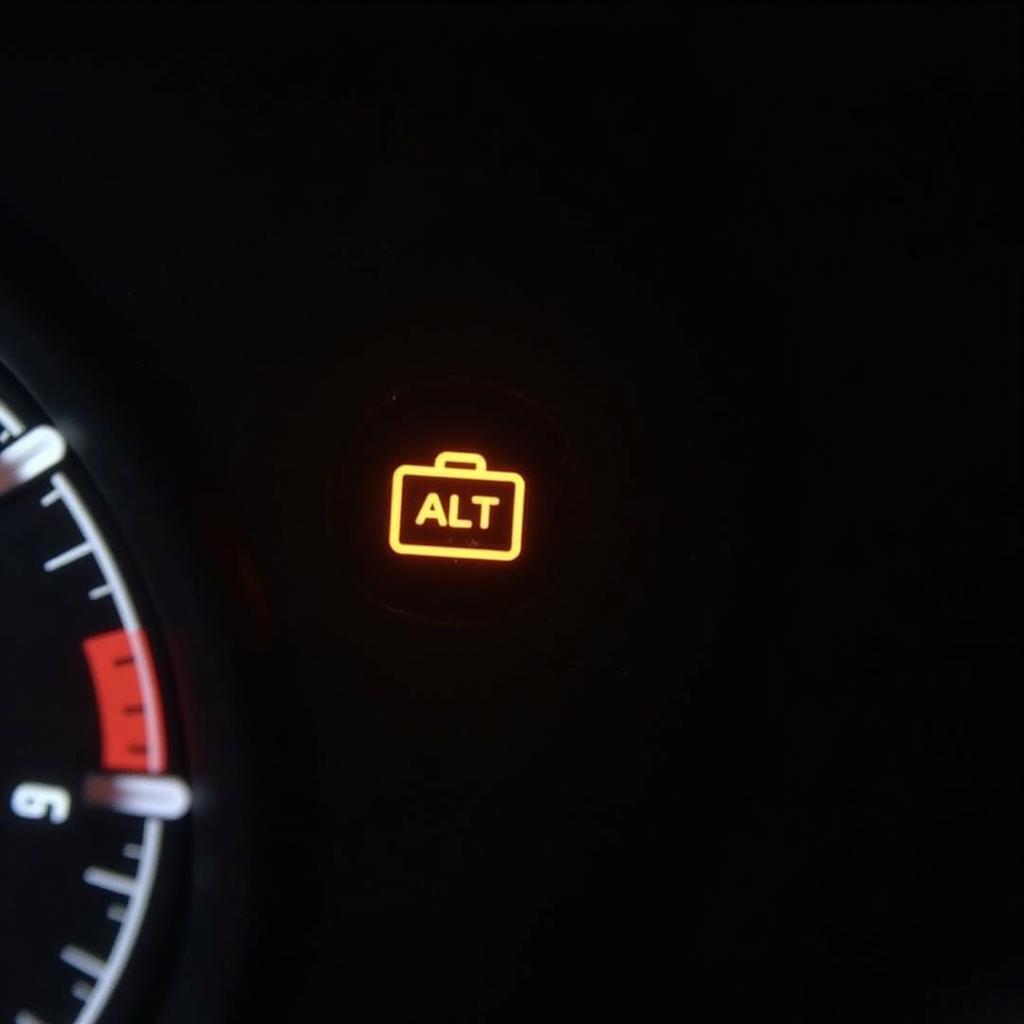A battery alternator warning light on your dashboard can be a real headache. This article will guide you through the causes, diagnostics, and even remote software solutions for resolving this pesky issue, helping you get back on the road safely and quickly.
What Does a Battery Alternator Warning Light Mean?
The battery alternator warning light, often symbolized by a battery icon or the letters “ALT” or “GEN”, indicates a problem with your vehicle’s charging system. This system, comprised primarily of the battery and the alternator, is responsible for powering your car’s electrical components and recharging the battery after starting the engine. When this light illuminates, it’s a signal that something isn’t right, and your battery isn’t being charged properly. Ignoring this warning can lead to a dead battery, leaving you stranded.
Common Causes of a Battery Alternator Warning Light
Several issues can trigger the battery alternator warning light. From a simple loose connection to a more serious alternator failure, understanding the potential culprits is the first step to a solution. Here are some of the most frequent causes:
- Faulty Alternator: The alternator is the heart of the charging system, generating electricity to power the car and recharge the battery. A failing alternator is the most common cause of the warning light.
- Dead Battery: Ironically, a completely dead battery can sometimes cause the alternator warning light to come on. This is because the alternator needs a minimal charge from the battery to begin working.
- Loose or Damaged Belts: The alternator is driven by a belt connected to the engine. A loose, worn, or broken belt can prevent the alternator from spinning and generating electricity.
- Wiring Problems: Corroded or damaged wiring within the charging system can disrupt the flow of electricity, triggering the warning light.
- Voltage Regulator Issues: The voltage regulator controls the output of the alternator. A malfunctioning regulator can cause the alternator to overcharge or undercharge the battery.
- Bad Ground Connection: A poor ground connection can prevent the alternator from properly grounding, leading to the warning light.
 Battery Alternator Warning Light on Car Dashboard
Battery Alternator Warning Light on Car Dashboard
Diagnosing the Problem
Diagnosing the exact cause of the battery alternator warning light requires a systematic approach. Here’s a step-by-step guide:
- Check the Battery: Visually inspect the battery terminals for corrosion or loose connections. Clean the terminals with a wire brush and baking soda solution if necessary.
- Inspect the Belts: Check the alternator drive belt for wear, looseness, or damage. If the belt is broken, it needs to be replaced immediately.
- Test the Battery Voltage: Use a multimeter to test the battery voltage. A fully charged battery should read around 12.6 volts.
- Test the Alternator Output: With the engine running, test the voltage at the battery terminals. It should read between 13.5 and 14.5 volts. A lower reading indicates a problem with the alternator.
- Check the Wiring: Inspect the wiring connected to the alternator and battery for any signs of damage or corrosion.
Remote Software Solutions for Battery Alternator Issues
In some modern vehicles, remote diagnostics and software updates can address certain alternator-related problems. For example, software glitches affecting the voltage regulator can sometimes be corrected remotely. These advanced diagnostic tools allow technicians to analyze vehicle data remotely and even install software updates wirelessly, potentially saving you a trip to the repair shop.
“Remote diagnostics and programming are revolutionizing the way we address vehicle issues,” says Alex Thompson, Lead Automotive Electrical Engineer at Advanced Auto Solutions. “We can often pinpoint and resolve software-related problems without the customer ever needing to bring their car in.”
Troubleshooting Tips and Prevention
- Regularly inspect your battery terminals and clean them if necessary.
- Have your alternator drive belt checked and replaced at recommended intervals.
- Address any electrical issues promptly to prevent further damage.
- Consider having your charging system inspected by a qualified technician annually.
“Preventive maintenance is key to avoiding charging system problems,” adds Thompson. “Regular inspections can catch potential issues early on, preventing costly repairs down the road.”
 Car Battery and Alternator Preventive Maintenance
Car Battery and Alternator Preventive Maintenance
Conclusion
A battery alternator warning light shouldn’t be ignored. By understanding the potential causes, following the diagnostic steps, and utilizing available resources, including remote software solutions, you can address the issue effectively. Regular maintenance and prompt attention to warning signs will help keep your car’s charging system in top shape and prevent you from being stranded with a dead battery.
FAQ
- What should I do if my battery alternator warning light comes on while driving? Safely pull over and check your battery and belts if possible. If the problem persists, it’s best to have the vehicle towed to a repair shop.
- Can I drive with the battery alternator warning light on? You can drive a short distance, but your battery will eventually drain, leaving you stranded. It’s best to address the issue immediately.
- How much does it cost to replace an alternator? The cost varies depending on the vehicle make and model, but it typically ranges from $300 to $800.
- How long does an alternator last? Alternators typically last between 80,000 and 150,000 miles.
- Can a bad battery cause alternator problems? A completely dead battery can sometimes trigger the alternator warning light, but it doesn’t usually cause long-term alternator damage.
- How can I prevent battery alternator problems? Regular maintenance, including battery terminal cleaning and belt inspections, can help prevent charging system issues.
- Can a loose battery terminal cause the alternator warning light to come on? Yes, a loose or corroded battery terminal can disrupt the charging system and trigger the warning light.

